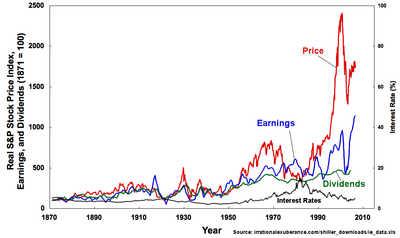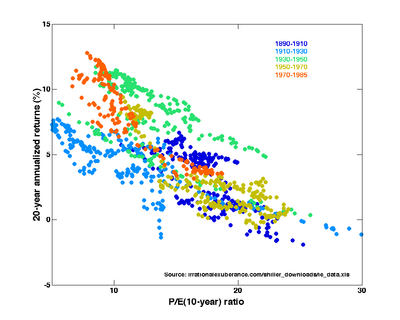روبرت ج. شيلر
روبرت شيلر Robert Shiller | |
|---|---|
 | |
| وُلِدَ | 29 مارس 1946 |
| الجنسية | أمريكي |
| الهيئة | جامعة يل |
| المجال | الاقتصاد المالي المالية السلوكية |
| المدرسة أو التقليد | الاقتصاد الكينزي الجديد |
| الجامعة الأم | مشيگن (البكالوريوس 1967) معهد مساتشوستس للتكنولوجيا (الدكتوراة 1972) |
| تأثر بـ | جون مينارد كينز فرانكو موديلياني جورج أكرلوف |
| إسهامات | الوفرة الطائشة، مؤشر كيس-شيلر |
| جوائز | جائزة البنك الهولندي (2009) جائزة نوبل في الاقتصاد (2013) |
| Information at IDEAS / RePEc | |
| التوقيع | |
 | |
روبرت جيمس "بوب" شيلر Robert J. Shiller (و. 29 مارس 1946[3])، هو اقتصادي، أكاديمي، وكاتب أمريكي شهير.
حالياً هو أستاذ سترلينگ في الاقتصاد بجامعة يل وزميل المركز الدولي للمالية، كلية الادارة، جامعة يل.[4] مساعد بحثي في المكتب الوطني للأبحاث الاقتصادية منذ 1980، وكان نائب رئيس الجمعية الاقتصادية الأمريكية عام 2005، ورئيس الجمعية الاقتصادية الشرقية 2006-2007. وهو أيضاً مؤسس مشارك وكبير الاقتصاديين في شركة ماكروماركتسز لادارة الاستثمار.
شيلر ضمن أكثر 100 اقتصادي تأثيراً في العالم.[5] نافسه طومسون رويترز على جائزة نوبل في الاقتصاد 2013 "لاسهاماته الرائدة في تقلبات الأسواق المالية وديناميكية أسعار الأصول".[6] في 14 أكتوبر 2013، أُعلن عن فوز شيلر، بالاشتراك مع اوجين فاما ولارس پيتر هانسن، بجائزة نوبل في الاقتصاد، "لتحليلهم التجريبي لأسعار الأصول".[7]
حياته العملية
حصل على بكالوريوس الفنون من جامعة مشيگن عام 1967، ماجستير العلوم من معهد مساتشوستس للتكنولوجيا عام 1968، والدكتوراة من معهد مساتشوستس للتكنولوجيا عام 1972 وكان عنوان أطروحته التوقعات المنطقية وبنية معدلات الفائدة تحت إشراف فرانكو موديلياني.[2] وهو مدرس في جامعة يل من 1982 وكان ضم طاقم تدريس كلية وارتون، جامعة پنسلڤانيا وجامعة مينيسوتا، وكذلك يلقي محاضرات في كلية لندن للاقتصاد. كتب شيلر في موضوعات اقتصادية متنوعة من المالية السلوكية إلى العقارات إلى ادارة المخاطر، ويشارك في تنظيم ورشات عمل حول المالية السلوكية مع ريتشارد ثالر منذ 1991. كتابه الأسواق الكلية حاز جائزة پول صمويلسون. حالياً ينشر شيلر عمود مشترك.
عام 1981، نشر شيلر مقال في أمريكان إكونوميك رڤيو بعنوان "هل تتغير الأسعار بسرعة كبيرة بحيث لا يمكن تفسير التغيرات اللاحقة في الأرباح؟"[8] وفيها تحدى فرضية كفاءة السوق، وكانت رأي سائد في المهنة الاقتصادية في ذلك الوقت. يزعم شيلر أن مساهمي سوق الأسهم العقلانيين يجب أن يعتمدوا في أسعار الأسهم على الأرباح المتوقعة في المستقبل، مخصومة من القيمة الحالية. درس شيلر آداء سوق الأسهم الأمريكي منذ العشرينيات، وأنواع التوقعات المستقبلية وأسعار الخصمومات التي يمكن أن تبرر مجموعة واسعة من الاختلافات من ذوي الخبرة في سوق الأوراق المالية. استنتج شيلر أن تقلبات أسواق الأسهم كانت أكبر بكثير من إمكانية تفسيرها بأي وجهة نظر عقلانية في المستقبل.
حازت مدرسة المالية السلوكية مصداقية جديدة في أعقاب إنهيار سوق الأسهم، أكتوبر 1987. يشمل عمل شيلر أبحاث المسح التي تسأل المستثمرين وتجار الأسهم عن ما يحركهم للمتاجرة؛ ظهرت نتائج عززت فرضيته بأن ما يحركهم هو العاطفة بدلاً من الحسابات المنطقية. معظم بيانات هذا المسح تم جمعها بصفة مستمرة منذ 1989.[9]


In 1991 he formed Case Shiller Weiss with economists Karl Case and Allan Weiss.[11] The company produced a repeat-sales index using home sales prices data from across the nation, studying home pricing trends. The index was developed by Shiller and Case when Case was studying unsustainable house pricing booms in Boston and Shiller was studying the behavioral aspects of economic bubbles.[11] The repeat-sales index developed by Case and Shiller was later acquired and further developed by Fiserv and Standard & Poor, creating the Case-Shiller index.[11]
His book Irrational Exuberance (2000) – a New York Times bestseller – warned that the stock market had become a bubble in March 2000 (the very height of the market top) which could lead to a sharp decline.
On CNBC's "How to Profit from the Real Estate Boom" in 2005, he noted that housing price rises could not outstrip inflation in the long term because, except for land restricted sites, house prices would tend toward building costs plus normal economic profit. Co‑panelist David Lereah disagreed. In February, Lereah had put out his book Are You Missing the Real Estate Boom? signaling the market top for housing prices. While Shiller repeated his precise timing again for another market bubble, because the general level of nationwide residential real estate prices do not reveal themselves until after a lag of about one year, people did not believe Shiller had called another top until late 2006 and early 2007.
In 2003 Shiller co-authored a Brookings Institution paper called "Is There a Bubble in the Housing Market?". Shiller subsequently refined his position in the 2nd edition of Irrational Exuberance (2005), acknowledging that “further rises in the [stock and housing] markets could lead, eventually, to even more significant declines... A long-run consequence could be a decline in consumer and business confidence, and another, possibly worldwide, recession. This extreme outcome ... is not inevitable, but it is a much more serious risk than is widely acknowledged.” Writing in The Wall Street Journal in August 2006, Shiller again warned that "there is significant risk of a very bad period, with slow sales, slim commissions, falling prices, rising default and foreclosures, serious trouble in financial markets, and a possible recession sooner than most of us expected.”[12] In September 2007, almost exactly one year before the collapse of Lehman Brothers, Shiller wrote an article in which he predicted an imminent collapse in the U.S. housing market, and subsequent financial panic.[13]
Robert Shiller was awarded the Deutsche Bank Prize in Financial Economics in 2009 for his pioneering research in the field of financial economics, relating to the dynamics of asset prices, such as fixed income, equities, and real estate, and their metrics. His work has been influential in the development of the theory as well as its implications for practice and policy making. His contributions on risk sharing, financial market volatility, bubbles and crises, have received widespread attention among academics, practitioners, and policymakers alike.[14][dead link] In 2010, he was named by Foreign Policy magazine to its list of top global thinkers.[15]
In 2011 he made the Bloomberg 50 most influential people in global finance.[16]
في 14 أكتوبر 2013، فاز د. شيلر بالاشتراك مع اوجين فاما ولارس پيتر هانسن بجائزة نوبل في الاقتصاد.[17]
كتب
- Finance and the Good Society Robert J. Shiller, Princeton University Press (2012), ISBN 0-691-15488-0.
- Animal Spirits: How Human Psychology Drives the Economy, and Why It Matters for Global Capitalism George A. Akerlof and Robert J. Shiller, Princeton University Press (2009), ISBN 978-0-691-14233-3.
- The Subprime Solution: How Today's Global Financial Crisis Happened, and What to Do about It Robert J. Shiller, Princeton University Press (2008), ISBN 0-691-13929-6.
- The New Financial Order: Risk in the 21st Century, Robert J. Shiller, Princeton University Press (2003), ISBN 0-691-09172-2.
- Irrational Exuberance, Robert J Shiller, Princeton University Press (2000), ISBN 0-691-05062-7.
- Macro Markets: Creating Institutions for Managing Society's largest Economic Risks byRobert J. Shiller, Clarendon Press, New York: Oxford University Press (1993), ISBN 0-19-828782-8.
- Market Volatility, Robert J. Shiller, MIT Press (1990), ISBN 0-262-19290-X.
انظر أيضاً
المصادر
- ^ Grove, Lloyd. "World According to ... Robert Shiller". Portfolio.com. Retrieved 2009-06-26.
- ^ أ ب Blaug, Mark; Vane, Howard R. (2003). Who's who in economics (4 ed.). Edward Elgar Publishing. ISBN 1-84064-992-5.
- ^ "The Closing: Robert Shiller". The Real Deal. November 1, 2007. Retrieved December 2, 2012.
- ^ "ICF Fellows". About. Yale University School of Management. Retrieved 21 September 2012.
- ^ "Economist Rankings at IDEAS". University of Connecticut. Retrieved 2008-09-07.
- ^ Pendlebury, David A. "Understanding Market Volatility". ScienceWatch < 2012 Predictions. Thomson Reuters. Retrieved 21 September 2012.
- ^ The Prize in Economic Sciences 2013, nobelprize.org, retrieved 14 October 2013
- ^ "Do Stock Prices Move Too Much to be Justified by Subsequent Changes in Dividends?". Nber.org. Retrieved 2013-10-14.
- ^ "Stock Market Confidence Indices". Yale School Of Management. Retrieved 2013-10-14.
- ^ أ ب ت Shiller, Robert (2005). Irrational Exuberance (2d ed.). Princeton University Press. ISBN 0-691-12335-7.
- ^ أ ب ت Katie Benner (2009-07-07). "Bob Shiller didn't kill the housing market". CNNMoney.com. Retrieved 2009-07-07.
- ^ ""No One Saw This Coming": Understanding Financial Crisis Through Accounting Models" (PDF). Munich Personal RePEc Archive. Retrieved 2009-12-16.
- ^ Shiller, Robert J. (September 17, 2007). "Bubble Trouble". Project Syndicate. Retrieved December 2, 2012.
- ^ "Center for Financial Studies : Home". Ifk-cfs.de. Retrieved 2013-10-14.
- ^ "The FP top 100 global thinkers". Foreign Policy Magazine. 2010.
{{cite web}}: Unknown parameter|month=ignored (help) - ^ "The 50 Most Influential People in Global Finance". Bloomberg.
- ^ "The Sveriges Riksbank Prize in Economic Sciences in Memory of Alfred Nobel 2013". Retrieved 10/14/2013.
{{cite web}}: Check date values in:|accessdate=(help)
وصلات خارجية
- Robert J. Shiller's website at Yale University Economics Department
- Faculty profile at Yale School of Management
- Robert J. Shiller, 2009 winner of the Deutsche Bank Prize in Financial Economics
- قالب:RePEc
- Column archive at Project Syndicate
- Appearances on C-SPAN
- روبرت ج. شيلر on Charlie Rose
- روبرت ج. شيلر at the Internet Movie Database
- Works by or about روبرت ج. شيلر in libraries (WorldCat catalog)
- أخبار مُجمّعة وتعليقات عن روبرت ج. شيلر في موقع صحيفة نيويورك تايمز.
- قالب:WSJtopic
- Roberts, Russ (September 15, 2008). "Shiller on Housing and Bubbles". EconTalk. Library of Economics and Liberty.
- أخرى
- Stocks Revisited: Siegel and Shiller Debate
- Robert Shiller's Workshop in Behavioral Finance
- The compelling Real DJIA, 1924–now
- Article on Robert J. Shiller (German language)
- Robert Shiller's interview on the housing crisis with The Politic
- Video conversation on the economy with Shiller and Robert Wright on Bloggingheads.tv.
- "Finance and the Good Society – Irreconcilable or Inseparable?" Presentation by Robert J. Shiller for the CFO Insight Magazine, August 2012
- Link to podcast lecture at London School of Economics on Sub Prime Crisis
- RSA Vision webcasts - Robert Shiller in conversation with Daniel Finkelstein on "How Human Psychology Drives the Economy"
- Interview with italian magazine House living and business
- Economic ratios maintained by Robert Shiller - P/E, Interest Rates, Divided Yields, Inflation, etc.
- CS1 errors: unsupported parameter
- Biography with signature
- Pages using infobox economist with unknown parameters
- Articles with dead external links from December 2012
- مواليد 1946
- أشخاص أحياء
- اقتصاديون ماليون
- اقتصاديون أمريكان
- طاقم تدريس جامعة يل
- طاقم تدريس كلية يل للادارة
- مالية سلوكية
- خريجو معهد مساتشوستس للتكنولوجيا
- خريجو جامعة مشيگن
- كتاب من دترويت، مشيگن
- كتاب أمريكان
- زملاء گوگنهايم
- حائزة جائزة نوبل في الاقتصاد
- حائزو جائزة نوبل أمريكان
